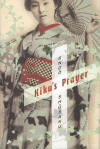Kiku’s Prayer
End? Sh?saku’s Kiku’s Prayer is not a typical love story. While passionate, it is never romantic. The mysterious village outsider Seikichi and tomboyish Kiku are star-crossed from the start when he rescues her from a tree branch about to snap. Their subsequent, infrequent meetings always end in arguments and tears. The source of their heartbreak is the impact of Japanese law on their lives long before and during the Meiji Restoration (1868-1912), because Seikichi is Catholic—a banned practice that for thousands meant imprisonment, torture, and death. Thus the love here is both personal and spiritual, and never easy.
End? Sh?saku’s Kiku’s Prayer is not a typical love story. While passionate, it is never romantic. The mysterious village outsider Seikichi and tomboyish Kiku are star-crossed from the start when he rescues her from a tree branch about to snap. Their subsequent, infrequent meetings always end in arguments and tears. The source of their heartbreak is the impact of Japanese law on their lives long before and during the Meiji Restoration (1868-1912), because Seikichi is Catholic—a banned practice that for thousands meant imprisonment, torture, and death. Thus the love here is both personal and spiritual, and never easy.
Kiku’s Prayer was first serialized in Japan in 1980 and published in book form in 1982. This is its first English translation. Religion, pain, and “East versus West” are crucial themes in Kiku’s Prayer because they were in the author’s life too. Sh?saku (1923-1996) was Catholic and studied briefly in France; several characters who interact with the couple are based on French missionaries and the officials who humiliated them. One of the few lighthearted scenes in the book is when Kiku takes her first bite of French sourdough bread “slathered with what tasted like hair oil.”
Sh?saku was sickly and hospitalized for extensive periods of time. This too is transferred onto Kiku. While courageous and outspoken for an uneducated peasant woman, the inner and outer struggles take their toll on her.
Seikichi is fierce in his convictions, but the blessing of being an outsider is obtaining a uniquely honest perspective. Kiku is not aware of the history of Christian persecution in Japan—the author and translator do an excellent job providing that for the reader—but she doesn’t need to be. Her intelligence, determination, and love become their own new testament. She resents Catholicism but understands it on a subconscious level. She finds great comfort a statue of Mary: “Never before today had she seen the face of a woman so pure, so clear. The woman in the statue was cradling an infant, and she wore a crown on her head. . . . It seemed as though the face looking down at her wore a gentle smile.” Catholics are fascinated by martyrdom and are occasionally very slow in officially recognizing the real thing. (Joan of Arc was not canonized until 1920; Archbishop Óscar Romero of San Salvador may never be). Readers will have no trouble recognizing the character of the strongest faith.
Her prayers are not rote; they are unrehearsed words from someone in pain. The statue creates and invites familiarity. Kiku has no problem letting Mary know that “All of this is your fault, I won’t forgive you unless you put everything back the way it was before,” or “I’ll get even with you! I’m not surrendering to the likes of you!”
Having Kiku’s Prayer take place in Nagasaki is a fitting choice. Missionaries concentrated their efforts there because it was a port city with a burgeoning international presence. Then too, the A-bomb is most likely on the reader’s mind and conscience. Sh?saku takes full advantage of both. He also cannot resist taking stabs at Japanese urbanization and industrialization. Employing a travelogue narration, he describes a place that lives only in memory:
If you walk around the neighborhood of the ?ura Catholic church today, you will occasionally spot one of the old wooden structures built in the Western style back in those days, looking now very much like abandoned houses . . . except for those few structures, the rest of the landscape was unspoiled hills.
Nagasaki was also known for Maruyama, its pleasure quarters. Sh?saku doesn’t have much to do with geisha but tactfully mentions that their nickname “wildcats” originates from their instruments being made from cat hides. To reach Maruyama visitors had to cross “The Bridge of Pondering,” torn down “thanks to land reclamation.” Beyond that was “The Bridge of Resolution” with its “unmistakable atmosphere.”
Pondering and resolution are both part of Kiku’s personality. Yet hard choices never harden her. She and Seikichi may not have had any ending other than the one Sh?saku gives them, but reading about them and the troubling time they lived in is itself a rewarding journey.





